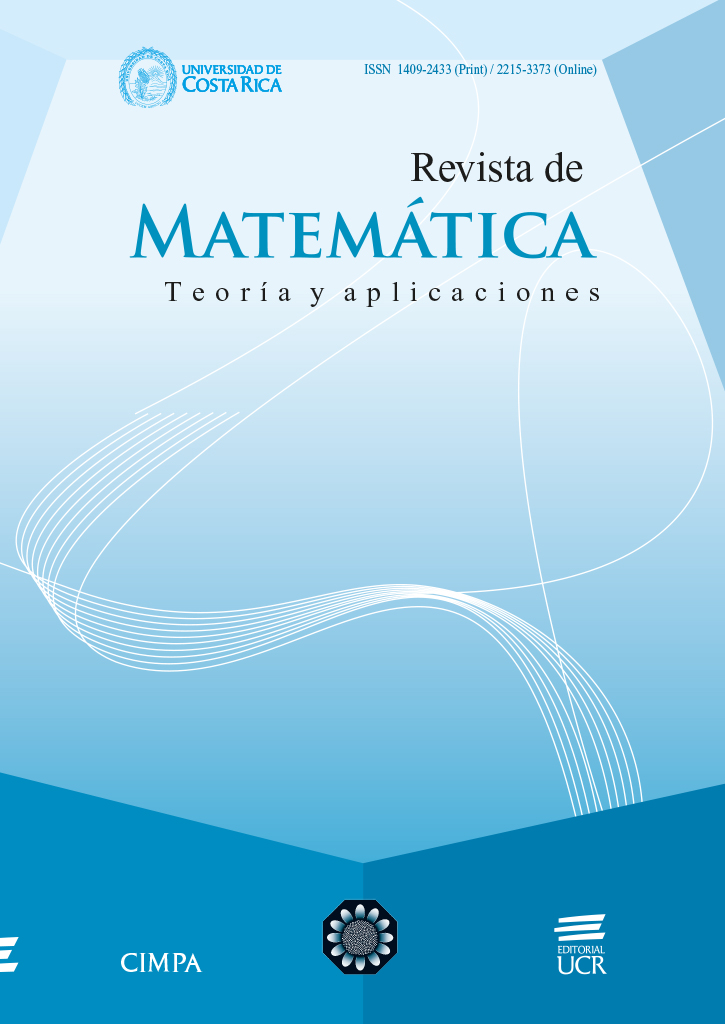Abstract
In this paper, two exact solutions of the Einstein’s equations are obtained for an anisotropic and homogeneous symmetry of Petrov Type D, the difference between both solutions lies in how relevant is the expansion that is presented initially, either on an axis or on a perpendicular plane. Both solutions represent a mixture of two fluids with minimum interaction: dark energy (P = −µ) and radiation (P = µ/3). The singularities and the influence that these fluids have on this metric are studied; the Hubble parameters, the deceleration parameter and the role that these fluids represent on them are determined and analyzed. Additionally, their temperature and the role that both play on this magnitude are determined.
References
R. Alvarado, Cosmological exact solutions set of a perfect fluid in an anisotropic space-time in Petrov type D, Advanced Studies in Theoretical Physics 10 (2016), no. 6, 267–295. Doi: 10.12988/astp.2016.6311
R. Alvarado, The Hubble constant and the deceleration parameter in anisotropic cosmological spaces of Petrov type D, Advanced Studies in Theoretical Physics 10 (2016), no. 8, 421–431. Doi: 10.12988/astp.2016.6930
R. Alvarado, Thermodynamics and small temporal variations in the equations of state of anisotropic cosmological models of Petrov type D, Advanced Studies in Theoretical Physics 11 (2017), no. 1, 9–17. Doi: 10.12988/astp.2017.6932
R. Alvarado, Exact cosmological solutions of isobaric scalar fields in space-times: anisotropic of the type of Petrov D and isotropic homogeneous, Advanced Studies in Theoretical Physics 12 (2018), no. 7, 319–333. Doi: 10.12988/astp.2018.8937
C.L. Chang, K.M. Huffenberger, B.A. Benson, F. Bianchini, J. Chluba, J. Delabrouille,. . . ,C. Zhang Cosmic microwave background measurements, Snowmass Cosmic Frontier, arXiv:2203.07638v1 [astro-ph.CO], 2021. arxiv.org/pdf/2203.07638v1
I. Dimitrijevic, B. Dragovich, A.S. Koshelev, Z. Rakic, J. Stankovic, Some cosmological solutions of a new nonlocal gravity model, arXiv:2006.16041 [gr-qc], 2020. arxiv.org/abs/2006.16041
R. Durrer, The cosmic microwave background: The history of its experimental investigation and its significance for cosmology, Classical and Quantum Gravity 32 (2015), no. 12, 124007. Doi: 10.1088/0264- 9381/32/12/124007
O. Farooq, B. Ratra, Hubble parameter measurement constraints on the cosmological deceleration-acceleration transition redshift, The Astrophysical Journal 766 (2013), no. 1, L7. Doi: 10.1088/2041-8205/766/1/L7
D. Huterer, The accelerating universe, Adventures in Cosmology (2011), 321–353. arXiv:1010.1162v3 [astroph.CO], 2011. arxiv.org/abs/1010.1162
J.A.S. Lima, R.F.L. Holanda, J.V. Cunha, Are galaxy clusters suggesting an accelerating universe independent of SNe Ia and Gravity Metric Theory?, AIP Conference Proceedings 1241 (2010), 224–229. Doi: 10.1063/1.3462638
A.M. Lopez, R.G. Clowes, G.M. Williger, A giant arc on the sky, arXiv:2201.06875 [astro-ph.CO], 2022. Doi: 10.48550/arXiv.2201.06875
J.C. Mather, E.S. Cheng, R.E. Eplee, R.B. Isaacman, S.S. Meyer, R.A. Shafer, . . . , D.T. Wilkinson, A preliminary measurement of the cosmic microwave background spectrum by the cosmic background explorer (COBE) satellite, Astrophysical Journal Letters 354 (1990), L37. Doi: 10.1086/185717
D. Mihu, Dynamical fluid-type universe scenario with dust and radiation, arXiv:1609.00589v2 [gr-qc], 2016. Doi: 10.48550/arXiv.1609.00589
S. Perlmutter, G. Aldering, G. Goldhaber, R.A. Knop, P. Nugent, P.G. Castro,. . . ,W.J. Couch, Measurements of omega and lambda from 42 highredshift supernovae, The Astrophysical Journal 517 (1999), 565–586. Doi: 10.48550/arXiv.astro-ph/9812133
A.G. Riess, A.V. Filippenko, P. Challis, A. Clocchiatti, A. Diercks, P.M. Garnavich, . . . , R.P. Kirshner, Observational evidence from supernovae for an accelerating universe and a cosmological constant, The Astronomical Journal 116 (1998), no. 3, 1009–1038. Doi: 10.1086/300499
A.G. Riess1, L.-G. Strolger, J. Tonry, S. Casertano, H.C. Ferguson1, B. Mobasher,. . . ,Z. Tsvetanov, Type Ia supernova discoveries at z > 1 from the Hubble Space Telescope: Evidence for past deceleration and constraints on dark energy evolution, The Astrophysical Journal 607 (2004), no. 2, 665–687. Doi: 10.1086/383612
B. Saha, H. Amirhashchi, A. Pradhan, Two-fluid scenario for dark energy models in an FRW universe-revisited, Astrophysics and Space Science 342 (2012), 257–267. Doi: 10.1007/s10509-012-1155-x
R. Sussman, D. Pavón, Exact inhomogeneous cosmologies whose source is a radiation-matter mixture with consistent thermodynamics, Physical Review D 60 (1999), 104023. Doi: 10.1103/PhysRevD.60.104023
M. Tsamparlis, A. Paliathanasis, Three-fluid cosmological model using Lie and Noether symmetries, Classical and Quantum Gravity 29 (2011), no. 1, 015006. Doi: 10.48550/arXiv.1111.5567
##plugins.facebook.comentarios##

This work is licensed under a Creative Commons Attribution-NonCommercial-ShareAlike 4.0 International License.
Copyright (c) 2022 Revista de Matemática: Teoría y Aplicaciones





